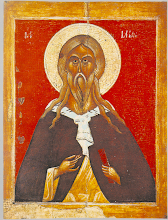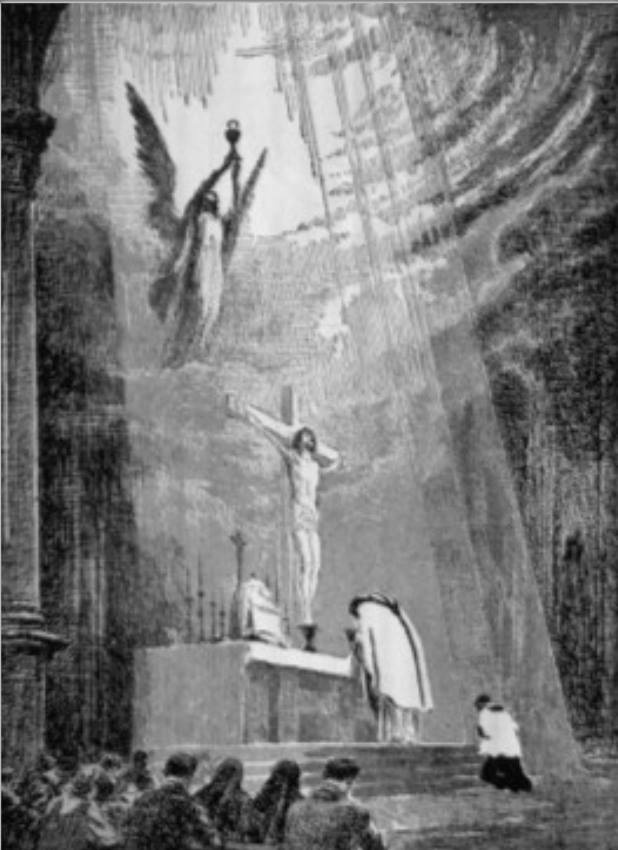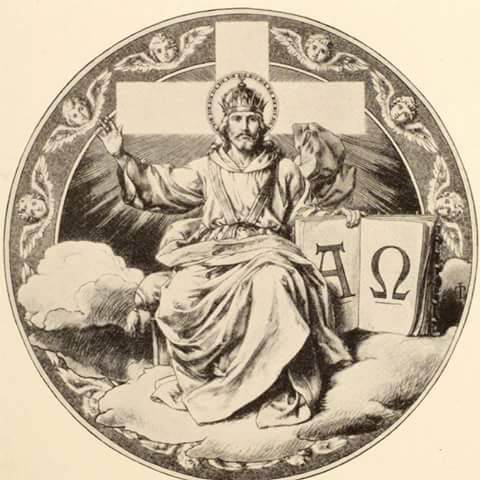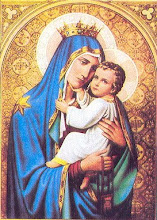On June 9, 1895, at the Carmel of Lisieux, Saint Thérèse made the Act of Oblation to Merciful Love.
In her autobiography she said: "I received the grace to understand,
more than ever, how much Jesus desires to be loved." Instead of offering
herself as victim to the justice of God, as did other religious, taking
upon themselves the "punishment reserved for sinners," Saint Thérèse
decided
to offer herself as a victim to the Merciful Love of God. She asked to
be consumed as a holocaust in the fire of the Sacred Heart, in order to
console that Heart and save souls. "Fire transforms all things into
itself, " the saint wrote in her Act of Oblation. "I know that the fire of love is more sanctifying than the fire of Purgatory."
From Help the Holy Souls:
The common
teaching within the Church is that Purgatory can hardly be avoided.
While still only a novice, the saint commented about this with one of
the sisters, Sr. Maria Philomena, who believed in the near
impossibility of going to heaven without passing through purgatory:
You do not have enough
trust. You have too much fear before the good God. I can assure you that
He is grieved over this. You should not fear Purgatory because of the
suffering there, but should instead ask that you not deserve to go there
in order to please God, Who so reluctantly imposes this punishment. As
soon as you try to please Him in everything and have an unshakable trust
He purifies you every moment in His love and He lets no sin remain. And
then you can be sure that you will not have to go to Purgatory.5
She even said that we would offend God
if we didn’t trust enough that we would get to heaven right after
dying. When she found out that her novices talked occasionally that they
would probably have to expect to be in Purgatory, she corrected them
saying: “Oh! How you grieve me! You do a great injury to God in
believing you’re going to Purgatory. When we love, we can’t go there.”6 Now,
this is a new doctrine, but only for those who don’t know God, who are
not childlike, who don’t trust. It is so correct to see things this way.
It is true that God will judge us at one point, but He is always and
first our Father Who… suffers when He has to punish His child and sees
its suffering. The child should do His will just out of love, and not to
avoid punishment. And this really means that God does not want
Purgatory! He allows that His children suffer, but only as if He had to look away.7 (Read more.)
It has come to my attention from perusing Facebook that there is a great deal of confusion about purgatory, especially among Catholics. The EWTN website offers excellent catechesis. To quote St. John Paul II:
According to Old Testament religious law, what is destined for God
must be perfect. As a result, physical integrity is also specifically
required for the realities which come into contact with God at the sacrificial level such as, for example, sacrificial animals (cf. Lv 22: 22) or at the institutional level,
as in the case of priests or ministers of worship (cf. Lv 21: 17-23).
Total dedication to the God of the Covenant, along the lines of the
great teachings found in Deuteronomy (cf. 6: 5), and which must
correspond to this physical integrity, is required of individuals and
society as a whole (cf. 1 Kgs 8: 61). It is a matter of loving God with
all one's being, with purity of heart and the witness of deeds (cf.
ibid., 10: 12f.)
The need for integrity obviously becomes
necessary after death, for entering into perfect and complete communion
with God. Those who do not possess this integrity must undergo
purification. This is suggested by a text of St Paul. The Apostle speaks
of the value of each person's work which will be revealed on the day of
judgement and says: "If the work which any man has built on the
foundation [which is Christ] survives, he will receive a reward. If any
man's work is burned up, he will suffer loss, though he himself will be
saved, but only as through fire" (1 Cor 3: 14-15).
3. At times, to
reach a state of perfect integrity a person's intercession or mediation
is needed. For example, Moses obtains pardon for the people with a
prayer in which he recalls the saving work done by God in the past, and
prays for God's fidelity to the oath made to his ancestors (cf. Ex
32: 30, 11-13). The figure of the Servant of the Lord, outlined in the
Book of Isaiah, is also portrayed by his role of intercession and
expiation for many; at the end of his suffering he "will see the light"
and "will justify many", bearing their iniquities (cf. Is 52: 13-53, 12,
especially vv. 53: 11).
Psalm 51 can be considered, according to
the perspective of the Old Testament, as a synthesis of the process of
reintegration: the sinner confesses and recognizes his guilt (v. 3),
asking insistently to be purified or "cleansed" (vv. 2, 9, 10, 17) so as
to proclaim the divine praise (v. 15).
Purgatory is not a place but a condition of existence
4.
In the New Testament Christ is presented as the intercessor who assumes
the functions of high priest on the day of expiation (cf. Heb 5: 7;
7: 25). But in him the priesthood is presented in a new and definitive
form. He enters the heavenly shrine once and for all, to intercede with
God on our behalf (cf. Heb 9: 23-26, especially, v. 24). He is both
priest and "victim of expiation" for the sins of the whole world (cf. 1
Jn 2: 2).
Jesus, as the great intercessor who atones for us, will
fully reveal himself at the end of our life when he will express himself
with the offer of mercy, but also with the inevitable judgement for
those who refuse the Father's love and forgiveness.
This offer of
mercy does not exclude the duty to present ourselves to God, pure and
whole, rich in that love which Paul calls a "[bond] of perfect harmony"
(Col 3: 14).
5. In following the Gospel exhortation to be perfect
like the heavenly Father (cf. Mt 5: 48) during our earthly life, we are
called to grow in love, to be sound and flawless before God the Father
"at the coming of our Lord Jesus with all his saints" (1 Thes 3: 12f.).
Moreover, we are invited to "cleanse ourselves from every defilement of
body and spirit" (2 Cor 7: 1; cf. 1 Jn 3: 3), because the encounter with
God requires absolute purity.
Every trace of attachment to evil
must be eliminated, every imperfection of the soul corrected.
Purification must be complete, and indeed this is precisely what is
meant by the Church's teaching on purgatory. The term does not
indicate a place, but a condition of existence. Those who, after death,
exist in a state of purification, are already in the love of Christ who
removes from them the remnants of imperfection (cf. Ecumenical Council
of Florence, Decretum pro Graecis: DS 1304; Ecumenical Council of Trent, Decretum de iustificatione: DS 1580; Decretum de purgatorio: DS 1820).
It
is necessary to explain that the state of purification is not a prolongation of the earthly condition, almost as if after death one were
given another possibility to change one's destiny. The Church's
teaching in this regard is unequivocal and was reaffirmed by the Second
Vatican Council which teaches: "Since we know neither the day nor the
hour, we should follow the advice of the Lord and watch constantly so
that, when the single course of our earthly life is completed
(cf. Heb 9: 27), we may merit to enter with him into the marriage feast
and be numbered among the blessed, and not, like the wicked and slothful
servants, be ordered to depart into the eternal fire, into the outer
darkness where "men will weep and gnash their teeth' (Mt 22: 13 and
25: 30)" (Lumen gentium, n. 48).
6. One last important aspect which the Church's tradition has always pointed out should be reproposed today: the dimension of "communio". Those,
in fact, who find themselves in the state of purification are united
both with the blessed who already enjoy the fullness of eternal life,
and with us on this earth on our way towards the Father's house (cf. CCC, n. 1032).
Just
as in their earthly life believers are united in the one Mystical Body,
so after death those who live in a state of purification experience the
same ecclesial solidarity which works through prayer, prayers for
suffrage and love for their other brothers and sisters in the faith.
Purification is lived in the essential bond created between those who
live in this world and those who enjoy eternal beatitude. (Read more.)
There can be children in purgatory, if they have committed any actual sins after reaching the age of reason and not expiated them on earth. From
The New Theological Movement:
Is
purgatory in the Bible?
While the word “purgatory”
never appears in the Bible, the concept is present both implicitly and explicitly.
Implicitly, the idea of praying for the dead – as when Job prays for his sons
and daughters, or in Maccabees, or when St. Paul encourages the Corinthians to
pray for the dead (cf. 1 Corinthians 15) – necessitates belief in purgatory. If
the dead are in hell, our prayers could do no good; if they are in heaven, then
they have no need of prayer. Therefore, there must be some third place (neither
in heaven nor in hell) where the souls of the dead can benefit from our
prayers.
The concept of purgatory is also
explicitly presented in the Bible. Consider when Jesus says that the sin of
blasphemy against the Holy Spirit cannot be forgiven in this life or in the
next (cf. Matthew 12:31) – thus, it is clear that some sins can be forgiven in
the next life (we mean the punishment of sin, not the guilt of sin). Likewise,
St. Paul states that some who have died will be purified as by fire: If any man's work burn, he shall suffer
loss; but he himself shall be saved, yet so as by fire. (1 Corinthians
3:15)
Must
I believe in purgatory in order to be saved?
Yes, purgatory has been taught
by the Catholic Church as de fide. To
deny the existence of purgatory is to deny the authority of Christ Jesus who
has revealed this doctrine to us through the Church. Hence, belief in purgatory
is as necessary for salvation as the other truths of the Faith.
What
is purgatory?
Purgatory is that purification
which they must undergo who have died in God’s grace and friendship, but are
still imperfect. Purgatory is “this final purification of the elect, which is
entirely different from the punishment of the damned.” (CCC 1031) Purgatory is a great and most generous gift from the Lord.
How
is purgatory different from hell?
Purgatory is essentially different
from hell insofar as the souls there still possess grace. The souls in
purgatory have faith, hope and love. Their punishment and suffering is of a
purifying nature and prepares them for heaven. Moreover, purgatory is only a
temporary purgation and all the souls in purgatory will eventually gain
entrance to heaven.
Hell, on the other hand, is
eternal. The sufferings of hell do not purify but only torture and punish. The
souls in hell have no grace, neither have they any (true) faith, hope or love.
The souls in hell will never attain to salvation.
How
is purgatory different from heaven?
Purgatory is a sort of ante-chamber
to heaven, a preparatory purgation for heaven. The souls in purgatory suffer
intensely and are not yet perfectly happy. The souls in purgatory still have
hope (rather than the fulfillment of hope in heaven), since they are not yet
perfectly possessed by God. Likewise they still have faith, since they do not
yet see God.
Do
the souls in purgatory become holier?
Essentially, the souls in
purgatory cannot grow in holiness. They cannot merit more grace or glory.
Neither can they grow in charity. Rather, purgatory is a cleansing which
purifies the holiness that they already possess.
Do
the souls in purgatory want to get out?
This is a difficult question.
On the one hand, they certainly desire heaven (this desire is cause of their chief
pain, since they are not yet where they want to be). On the other hand, they
would not want to move ahead without being purified. Hence, they love the
sufferings insofar as they are purified by them. None are angry or upset about
being in purgatory, but they do very much desire the assistance of our prayers
so as to swiftly attain to the joy of heaven.
Are
there any young children in purgatory?
No, there are most certainly no
children who died before the age of reason in purgatory. Purgatory is a
punishment for actual sin (either direct sins or sins of omission). Hence,
since a child cannot sin until it has attained to the use of reason, it is not
possible for any children to be in purgatory.
If the child has been baptized,
it most certainly goes directly to heaven. If the child has not been baptized,
it either goes to limbo (which is a state of perfect natural happiness, on the fringe of hell) or to heaven.
In any case, young children who
die before gaining the use of reason are very happy, indeed they are perfectly
happy. They are either supernaturally happy in heaven, or naturally happy in
limbo – but they certainly do not suffer any subjective pains (as do the souls
in hell and in purgatory).
Will
purgatory go on forever?
No. Purgatory will be completed
at the time of the final judgment. All the souls in purgatory at that time will
be purified instantaneously and will be caught up with the saints in glory.
Is
there really fire in purgatory?
Yes. There is real, physical
fire in purgatory. This is the best and safest opinion which is nearly
unanimous among the Latin theologians (especially the Fathers and Doctors),
also it enjoys the favor of several prominent Eastern Doctors (including St.
Basil the Great). Additionally, the mystics of the Church speak of physical
fires.
It is in this sense only that
purgatory can be called a “place”.
How
can I help the souls in purgatory?
You can help the poor souls by
praying for them, offering up works of mercy, gaining indulgences for them,
mortifying yourself in their behalf, and completing other spiritual works for
their sake. [Be sure that no prayer will go to waste; since, if the soul is not
in purgatory (for one reason or another), Our Blessed Mother will certainly
make good use of the graces for another]
Most especially, we consider the
importance of praying for the holy souls when at Mass (especially during the
Eucharistic prayer), and having Masses offered for the deceased.
Can
the souls in purgatory help me?
This is a very complicated
question. Generally we would say, no. The main point of purgatory is that the
souls cannot help themselves or anyone else, but are in a passive state of
purification. They are powerless, hence they rely greatly upon our prayers.
However, it is possible that
God may (in exceptional circumstances) allow those in purgatory to pray for or
assist in some manner those who are on earth and who implore their aid. Still,
this does not seem to be the norm – however, there are most certainly cases in
the lives of the saints (e.g. St. Pio) where this did occur. (Read more.)






































